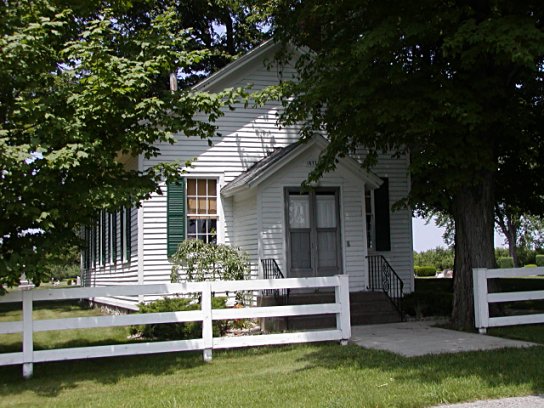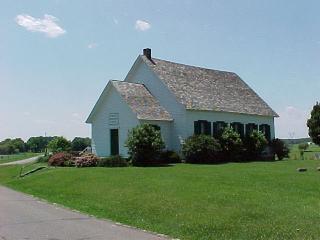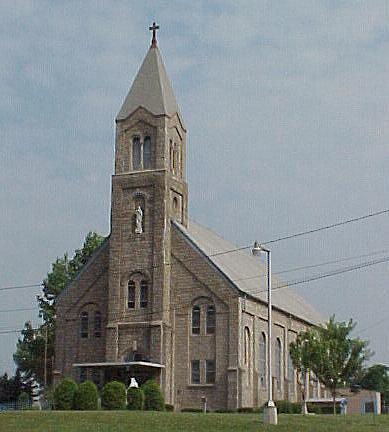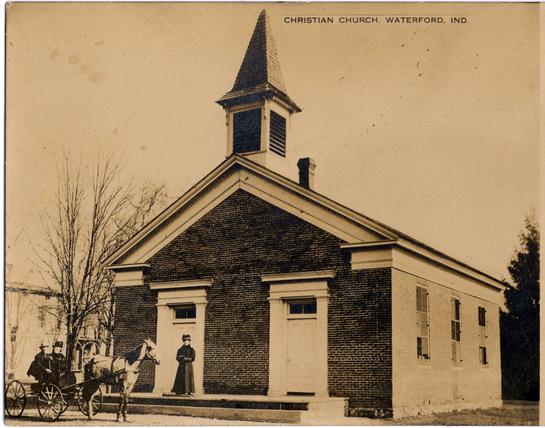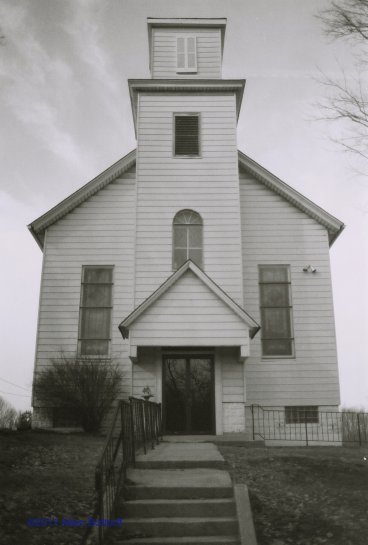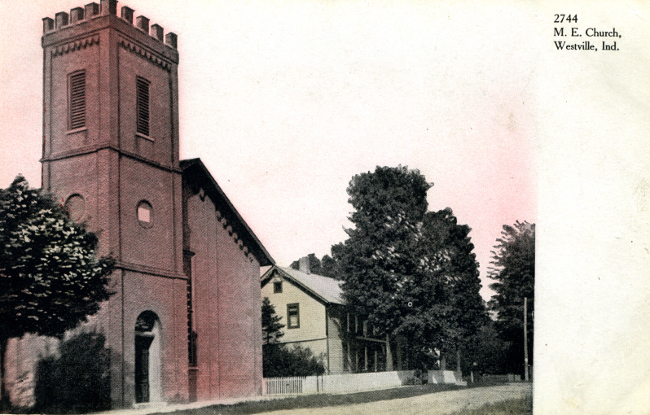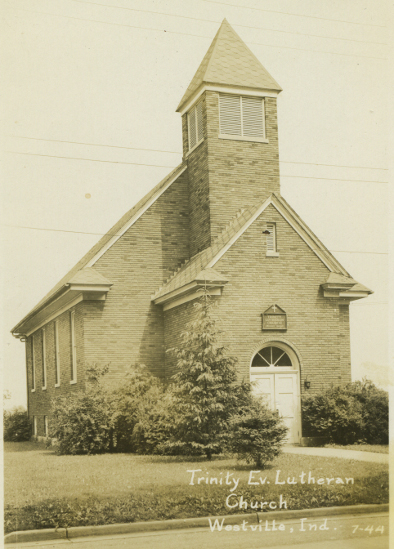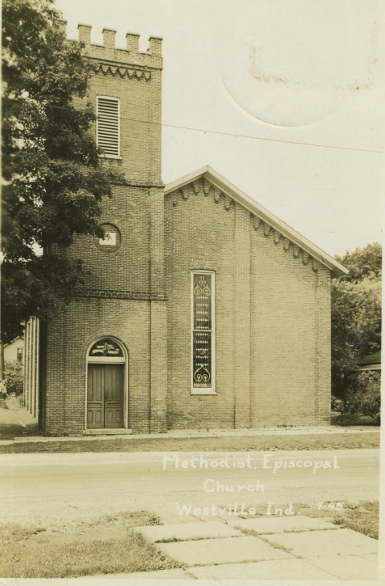Houses Of Worship
Coolspring & New Durham
Twps
La Porte County, Indiana
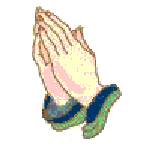 Histories for the churches listed
below are being worked on at the present time. In time we hope to
gather many of the histories of the churches pictured below. But this all takes
time. If you have a history on any of the
Histories for the churches listed
below are being worked on at the present time. In time we hope to
gather many of the histories of the churches pictured below. But this all takes
time. If you have a history on any of the
LaPorte County Old Houses of
Worship and would like to share it with us and/or contribute photos of the
same,
contact us at laportecountyin@yahoo.com
Also
See the History of LaPorte County where many are mentioned.
Coolspring Churches
Presbyterian Church
Services were held in homes and then school
houses until the first church was built in about 1855 near Waterford. This was
the only known church building in township during the early part of the history
there in. The church was really a union church and was used by several
denominations.
New Durham Churches
The History of Carmel Chapel and Cemetery
By Bruce R. Johnson
In the year of 1869, many Swedish families were settling in and near
the hills located in southeastern Coolspring, southwestern Center, northwestern
Scipio, and northeastern New Durham Townships of La Porte County, Indiana. Many
of these people were members of the Swedish Evangelical Lutheran Church of La
Porte now known as Bethany Evangelical Lutheran Church.
It was very trying and difficult to make the
journey to La Porte as the roads were bad. Walking or horse and buggy
transportation was very slow and time consuming. It would often require from
one and one-half to two hours to make the trip, depending on the time of year.
These settlers were church-minded and believed they had a sufficient number of
members to erect a house of worship near or centrally located to each family. A
spot was suggested in the northeastern corner of New Durham Township.
A meeting of the Swedish settlers was called on
April 14, 1872. Mr. John Anderson was chosen chairman and John Bard, secretary.
After some discussion it was decided to purchase from John Peterson an acre of
land sixteen rods north and south and ten rods east and west. The purchase
price was $70.00. If necessary, five years was allowed to pay for it at 10%
interest. However, it was fully paid in a few months. The title of the land was
in the name of Swedish Evangelical Lutheran Church of New Durham Township of La
Porte, County, Indiana. These settlers were first concerned to erect a
schoolhouse or house of worship, which was done promptly, and a carriage house
was built near the road for the pastor’s horse and buggy. Sunday School
and worship services were held on Sunday afternoons by the pastor of Bethany in
La Porte. Services were conducted in the Swedish language. Bible School was
held for many years in the summer.
On August 9,
1874 thought was given to have a place of burial near this house of worship,
which was an old custom. Twenty lots were plotted at 16 X 16 feet with an aisle
of 8 feet. There were three aisles north and south with five lots facing each
aisle. These lots were sold for $4.00 and $3.00, due to location, and promptly
purchased in a few months. Soon over 40 lots were plotted and added.
On June 5, 1882 the name was chosen as Swedish
Evangelical Lutheran Carmel Chapel and Carmel Cemetery. It was also decided to
register and incorporate the chapel and cemetery in accordance with state laws.
About 1915 the cemetery and chapel were only called
Carmel. The Swedish language was dropped. The cemetery was then opened to all
people regardless of church affiliation. Additional land was purchased in 1904.
Later, more land was donated by the Ryden estate. The early purchasers of lots
placed a curb or fence around their lots, which raised them above the aisles.
In 1937 lot owners were requested to remove the
curbstones and fences, which was eventually done. This was done in order to
take care of the cemetery more easily. A Civil War veteran named Andrew Johnson
was the first person buried in the cemetery. Nearly all of the original
settlers are now resting in Carmel Cemetery. Some of the more prominent family
names are Anderson, Carlson, Erickson, Garwood, Gustafson, Johnson, Larson,
Lindborg, Magnuson, Olson, Palm, and Swanson. During 1917 a group thought it
well to establish a fund that could be invested and the interest used to assist
in the upkeep of the cemetery. The amount of $1300.00 was collected within a
few days. When the Carmel Endowment Fund reached $2000.00, it was invested at a
rate of 5% interest and so held for several years.
In 1946 the Carmel Cemetery Board of Trustees
decided to transfer the property to the Bethany Evangelical Lutheran Church of
La Porte, Indiana, but received the privilege to elect their own board members
at the annual meeting which is held on the Sunday before Memorial Day. The
Board members are elected for three years and can be re-elected. The board
members must be members of Bethany Lutheran Church.
Baptist Church - Westville - . Arrival of many Baptist families
was in 1856 (circa)
Christian Church
of Westville and was formed in about 1857
a building was built in 1859. Elder H. Z. Leonard was the first pastor.
Methodist Church
New Durham Township, Pinhook town
In
1847 a Methodist church was built in New Durham and the first minister was Rev.
J. J. Cooper. Rev. Mr. Parrott, previous to that time, had conducted religious
services for the Methodists in private homes.
This church, although services
are no longer held there, is the oldest standing church building in the county.
Lutheran Church of Westville, Indiana - The Lutherans arrived
in about 1855.
Methodist Episcopal Church in Otis - first service in
1870.
Methodist Church in Westville, Indiana - a pioneer church.
Historically: Methodism moved into this area in about March of 1829 and located
on the land now known as Westville.
Rev. James Armstrong in the fall of
1832 was appointed Presiding Elder of the most northern district (of the
Indiana Conference). This extended from LaFayette on the south to Kalamazoo
Michigan and from the Ohio line to the Illinois line. Mrs. Armstrong found when
he came to the work. a small class had been former at a Mr. Ahart's home
(acturally William Eahart) near Westville, by Jeremiah Sherwood, a local
preacher who had preceded him in the county.
1836 Classes were formed at
the home of Henly Clyburn, near Westville. In the same year Mr. Clyburn built
the first permanent residence in the wotn. Later it would be owned by his
granddaughter Pearl Gardner Ansley.
A chruch was built in 1843 and later
sold to the Catholic Church.From 1843 until 1857 the church was served by
preachers from Union Circuit and then organized as a circuit with Frank Taylor
as pastor.
A new church was built circa, 1867-68. At a later date the older
building was sold to the Lutherans.
The official name of the church today is
Westville United Methodist Church. Caleb Mock was the pastor from the
fall of 1866 to Sept. 1868. Daniel West, a fine Christian and
public-spirited citizen, bequeathed $5000 to the church; and by the
subscription of friends, in addition, the building was made possible. Before
this Rev. James Armstrong, a Methodist minister arrived around 1832 he found a
clan of Methodists already meeting at the home of William Eahart, under the
direction of Jehemiah Sherwood. The new church was built in 1931-32.
This
church built in 1868 still stands today, although improvements and additions
have been made to it.
Pinhook Methodist Church Article from their Bencyation
Celebration 1847-1989 - This little white clapboard sided building still stands
today. Carpenters, McLung and Nelson Barnard built the church from handhewn
Walnut logs in 1847 on land that Wm. Garwood had donated, stating "I give this
land for the purposee of a chruch. It shall be forever and forever."
Lester
Loomis and his brother halued stones for the foundation. The first sermon was
preached by Re. James Armstrong, who came during the Sak Indian War and stayed
to lead a flock headed by Jeremiah Sherwood.
Church was
first served by a Methodist circuit rider, later become a joint parish with
Westville and Door Village. When the congregation could no longer support a
full-time pastor, the church was closed in 1968 and deeded over to the Pinhook
Cemetery Association by the Methodist Conference.
Saved from the wrecking
ball: In 1977, member of the Cemetery Association talked of destroying the
church and using the land for additional burials. But the pelase of the
community were heard and the cemetery board granted a stay. IN 1987 the church
was then renovated and the leading roof and other bruises of age were repaired.
The restored church was a labor of love from Julia Alt and Phyllis Marks, who
with their husbands, Vernon and Tom, spearheaded the restoration efforts.
Community volunteers, LaPorte County Work Release
prisoners, Westville Correctional Center inmates, local businesses and
merchants and untold donors are on the list of those who gave help to restore
this old beauty.
St. Mary's Catholic Church in Otis - First church was built in
1872 and completed in the Spring of 1873. Many of the first parishioners were
from Keynia, Szubin and Krolikowo, Posen (which at that time was a part of
Germany). Reverend Szulak, blessed the new church. Pastors from the beginning
of the church to 1932 were:
Rev. Peter Koncz and remained until July of
1875.
Rev. Louis Machdzicki 1875 to August 1881.
Rev. Urban Raszkiewicz
August 6, 1881 to 1909 when he died.
1909 to 1914 the following priests
served at St. Mary's - Rev. Alexander Buechler,
Rev. Peter Budnik
Rev.
Thomas Jankowski
Rev. John Wroblewski became pastor on July 6, 1914. He and
the parishioners redecorated the interior and the exterior of the church.
In
February 21, 1917, a fire destroyed the church. The only building left standing
was the school house where services were temporarily held.
Another sad note
should be added here. When the church and rectory burned, all church and
cemetery records were lost.
In 1918 A new church building was started. And
in May 1919 the new church was completed. Father Wroblewski "boarded out" until
the new rectory was completed in 1922.
Rev. John Biernacki served for
approximately five years (1927 to 1932.
On September 15, 1932 Rev. John
Biernacki and Rev. John S. Hosinski exchanged parishes.
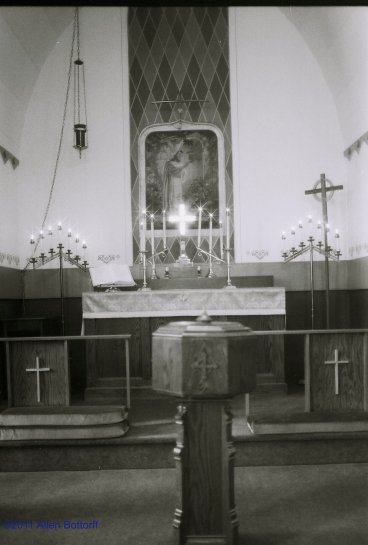 St. Pauls Evangelical
Lutheran Church at Otis1855 to present.
St. Pauls Evangelical
Lutheran Church at Otis1855 to present.
Also known as "The Toll Road
Area Church".
Following article written by: Warren A. Ransom (1915 to
1995)
St. Pauls 1855 - 1985
From the beginning of its existence in 1855,
St. Pauls Lutheran Church of Otis has served its community and its people with
great pride, although the church was not built until 1874. The church located
on a hill celebrated its 90th anniversary in Sept. 1963. The Rev. Karl Hofmann,
acting pastor, stated that June 17 was selected for various reasons of
convenience and expediency as well as the Sept. 15 date according to the
records. The first baptism recorded in the combined records of both the
Westville and St. Pauls Trinity Lutheran Church was on Aug. 6, 1871. However
the records indicate that Lutheran Services were conducted as far back as 1855
by Rev. Mr. Bofinger of Valparaiso, who was active until 1865. From 1865 to
1871 the church work was continued by Rev. Meyer pastor also of Valparaiso.
Then the Rev. Mr. Heber, a graduate of the Lutheran Seminary, began his
pastoral duties. His stay was quite short in the Westville and Otis area, but
it was he who intensified the work at Otis resulting in the organization of St.
Pauls church in 1873.
The Pastor for St. Pauls church
also serve Westville Trinity Lutheran Church. The Sunday school classes and
Worship Services were staggered enabling the Pastor to conduct sermon topics to
both congregations weekly. In 1874, a modest small structure was built under
the leadership of the Rev. W. J. B. Lang of Valparaiso. The Congregation still
worships in the same building.
The Rev. F. W. Schlechte entered the parish in 1882, and remained with
them until 1895. It was under him that the Sister Congregation Trinity was
formally organized as a congregation in 1887. In 1895, Rev. M. C. Baade assumed
the pastorate for his first time of service. He also resided in Otis. In 1903,
the Rev. E. H. Polzin became pastor. Now the area of Otis began to grow . A
group of Lutherans in Michigan City were organized and they were being served
by Rev. Polzin. When he left in 1912 he was followed by Rev. O. A. Sauer. He
served not only Otis and Westville but the Lutherans of Michigan City. However,
when Rev. Sauer left the parish was faced with the problem of finding another
pastor. Michigan City, a seed congregation from the mother church of Otis,
decided that it was large enough and strong enough to start out on its own.
Accordingly they decided to withdraw from the parish and to issue a call for
their own pastor. There was some discussion as to the separation of both Otis
and Westville. However, it was decided that it would be best if they remain
together. They called Re. Paul Buck and it was decided the pastor would reside
in Westville rather than Otis.
In 1933 Rev. Edgar P. Schmidt was installed pastor, then in 1948, Rev.
Behrans was pastor and the first one to move into the new parsonage in
Westville. It has been remodeled, redecorated and refurbished over the years.
.....
A new organ was purchased in 1957 and dedicated on April 27, 1958,
...(article describes other improvements).... The Rev. Hofmann state during the
entire history of the St. Pauls, the church has been the recipient of numerous
memorials. ....
The Ladies Aid Society of the church was
organized in 1908 with Mrs. Hildebrand as president. Group disintegrated after
several decades. The society was re-organized and new constitution
adopted.
Other details noted in Mr. Ransom article are:
Feb 1948 - 16
charter member were : Mrs. Rudolph Duetscher, Mrs. Lloyd Mattote, Mrs. Elmer
Miller, Mrs. Marion Miller and Mrs. Lester Radke. Other officers were Mrs. L.
J. Watson, Mrs. Lester W. Radke, Mrs. Lloyd Mattote. Contact the church for a
continuation of the church in later years after 1957.
Trinity Lutheran Church of Westville - Organized on January 9th
1887, sixteen members signing the constitution.
Serviced conducted as early
as 1855 in private residences by pastors from Otis.. etc.. The Rev. F. W.
Schlechte, who resided in Otis and led the congregation 1882 to 1895. During
this era the congregation was officially organized.
May 13th, 1888 they
purchased the Catholic chursh building adjacent to the Westville school.
Previously services were conducted in the old Baptist Church which later was
remodeled as a home for L. R.Cass.
Others who served the church were: Rev.
M. C. Baade in 1895, Rev. E. H. POlzin in 1903; and Rev. O. A. Sauer from 1921
to 1921.
In 1922 a parsonage and vacant lot were purchased in hopes of
building a new church.
1925 - Rev. Paul F. Buck (1922 -
1925 pastor) went to Wisconsin and Re. H.W. Medler too charge. The erection of
the new chuch began during the pastorate of Rev. Curtis C. Stephan (1930 -
1933). It was dedicated January 17, 1932.
1933, Rev. Edgar P. Schmidt
becamse its pastor . Rev. Howard C. Behrens, who served the church during a
granted absence of Rev. Schmidt, was installed as pastor. And in 1942 a
parsonage was purchased and later sold to permit the building of a new
parsonage on the church proptery. The Behrens family first occupied the new
home in April of 1948.
January 15th, 1950 Rev. W. M. Ave Lallemant was
installed. This church continues now into present times.
Union Chapel was the first church within New Durham Township
and was built in 1839 in section 34.
Universalist Church -
1837 to 1838 - William C. Talcott -
Served as probably the 1st minister.
Home
Page
La Porte County Indiana Gen Web
Copyright 2006
 Histories for the churches listed
below are being worked on at the present time. In time we hope to
gather many of the histories of the churches pictured below. But this all takes
time. If you have a history on any of the
Histories for the churches listed
below are being worked on at the present time. In time we hope to
gather many of the histories of the churches pictured below. But this all takes
time. If you have a history on any of the 